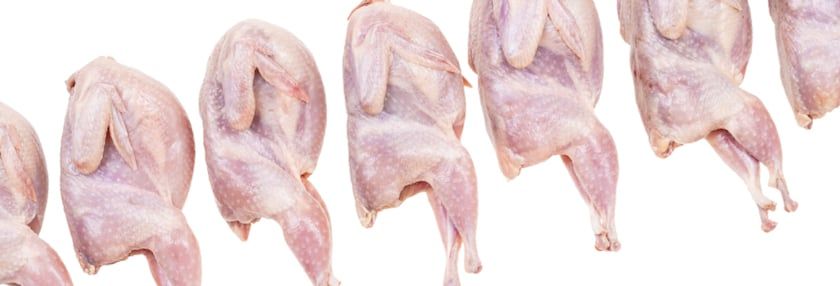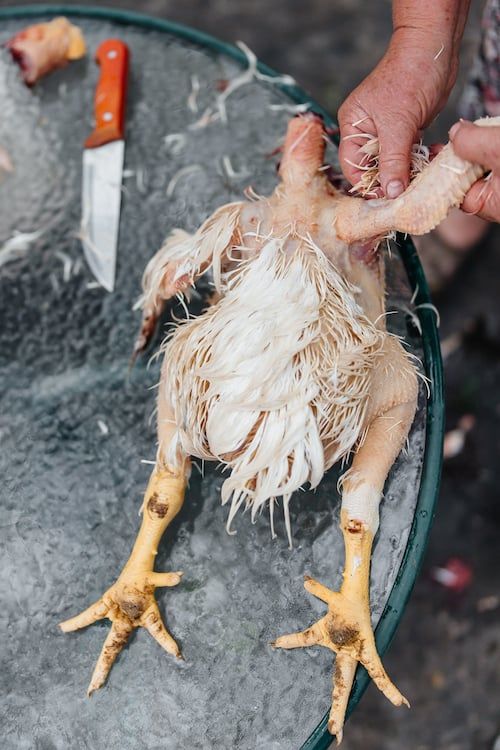Speed Up Your Processing Day


Having the right tools is essential
Raising meat chickens is not everyone’s cup of tea, but bird processing is an age-old part of poultry keeping. There are several steps to moving from a live bird to a carcass that can be stored in the freezer.
The entire process can be done by hand with little more than a sharp knife and a sturdy table, but there are other tools out there to make the process so much easier.
So let’s take a closer look at some tools designed for a backyard poultry processing day. These tools would be appropriate if you alone processed twenty-five chickens every few weeks, or if you had a processing day where you and your neighbors processed up to 100 birds in a day, given enough helpers on hand.
Feather pickers
The longest and most-time consuming part of processing is removing the feathers. A picker uses rubber picker fingers to remove the feathers from an already scalded carcass. (We will talk about scalding in a moment.) The picker fingers do not break the skin, and they are ridged so the finger’s shape pulls the feathers free from the follicle. There are 3 styles of feather pickers used by backyard flock owners.
A drill picker attachment is the smallest and at under $100, the least expensive. You will need to use a drill that has been clamped to a table. You will need to first pluck by hand all of the tail and large wing feathers before using this picker style.
Holding the carcass takes two hands, you are exposed to the spinning picker as you turn and move the carcass during picking, which can be a bit unnerving if your hand should bump up against a picker finger. It also takes longer than some other pickers simply because you need to turn the bird and move parts around so that all feathers are removed.
My experience is that it takes about 2 minutes and I still end up hand picking some small sections of the carcass.
The largest variety of drill attachments, kits, and replacement picker fingers I have come across is from CoopsNMore. This company carries the Rite Farm product line of processing equipment as well as equipment for many species of poultry.
A tabletop picker is not much larger than a drill attachment picker. Some have legs attached or are designed to just sit on your own table. The nice part is that there is usually a guard to prevent you or the carcass from coming into contact with the spinning cylinder covered in rubber picker fingers.
You will often need to pull the longer tail and wing feathers before placing the bird on the picker and you still use two hands to flip the bird around and side to side in order to let the picker fingers reach all parts covered in feathers.
You can expect to pick a whole bird in about a minute and a half. I may still end up removing some very small sections of feathers with my fingers, but far fewer than with the drill attachment.
This type of picker is a little more stable and provides more protection for the user.
With these advancements comes a bump in price. You can expect to pay between $450 to $500 for this type of picker if purchased from Murray McMurray Hatchery. A similar model from Cutler Supply is $375. If kept in good condition, however, this style of picker will last the lifetime of your farm.

Drum pickers are my favorite style of picker—it makes picking very fast and even a little comical.
Birds are dropped into the center of a drum with sides and bottom covered in rubber picker fingers. The bottom rotates to move the bird around inside the drum, removing the feathers. This is where the comedy comes in because birds dance around inside the drum in a floppy, haphazard manner.
Water is sprayed into the drum picker of some models while a chute pushes the feathers in a particular direction. Depending on the model, a hose attached to the inside of the drum picker provides the rinse needed for feather removal and for washing feathers down the chute.
Picking a carcass is usually complete in under 20 seconds.
This style of picker can be made of different materials; be heavy or light; and cost ranges widely depending on size and maker. Hatching Time makes a picker made of plastic that is light enough to carry to and from storage—perfect for a mobile poultry processor and costs $590-$760 depending on size. Featherman Poultry Processing Equipment also makes a feather plucker made of plastic, with a cost upwards of $1800.
Stainless steel pickers are durable, and much heavier. Most do not have wheels but I found one at Roots & Harvest for $480 which is easily the best price for a product of that size I have seen. Similarly, the Yardbird Chicken Plucker runs about $500. Both Murray McMurray and Stromberg’s carry stainless steel pluckers of slightly different makes and prices. I recommend choosing one with wheels because these units are quite heavy.
Scalders
In order to remove feathers, the skin must first be scalded. A scalder can be something as simple as a hot pot of water or stock pot, but most people do not have stock pots at home that are large enough.
A large stock pot, like a turkey fryer, can work as well. A regular propane tank and propane burner beneath heats up the water.
The main drawback: wind. In my case, more often than not, I am spending a part of my day re-lighting, or evaluating the status of, the propane burner. Temperature control can be iffy, and water needs to be added to the stock pot periodically, also cooling the water.
This method of scalding, depending on the size of stock pot you purchase can run you between $80-$200.
Electric scalders are an option, and these range from small to large in size. The small fiberglass scalder that you can find at Murray McMurray for $240 is large enough for one bird at a time and it takes a while to heat up.
I like the mid-size of the stainless steel scalders from Roots & Harvest and Stromberg’s. They do not require 220 V outlets—regular household power only—and have drains at the bottom to unload the water at the end of a day, and are still small enough to store.
I also like that I can “set it and forget it.” My scalder from Roots and Harvest is easy to turn on, will take between 1-2 hours for it to reach temperature, and it won’t blow out like propane-fired scalders. Plus, that eliminates constant temperature-checking. Roots & Harvest charges $350 for their scalder and Stromberg’s is $100 more.
On the large end, there are propane-fueled scalders of different sizes from Ashley. These tend to run upwards of $5,000 and are more appropriate for a small processing plant. But if you are thinking big…
I hope this helps with some of the decisions as you approach chicken processing. Having both a picker and a scalder are worth the investment.
Tags:Plain Talk

Chicken Whisperer is part of the Catalyst Communications Network publication family.











